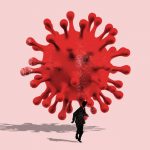Cases have surged in China since it dropped its zero-COVID policy in December, and the latest models now suggest that at least 1 million people may die as a result. Many countries have responded by policing their borders: Last week, the CDC announced that anyone entering the United States from China would be required to test negative within two days of departure; the U.K., Canada, and Australia quickly followed suit; and the European Union has urged its member states to do the same. (Taking a more extreme tack, Morocco has said it will ban travelers from China from entering altogether.) At a media briefing on Wednesday, World Health Organization Director-General Tedros Adhanom Ghebreyesus said, “It is understandable that some countries are taking steps they believe will protect their own citizens.”
On Tuesday, a Chinese official denounced some of the new restrictions as having “no scientific basis.” She wasn’t wrong. If the goal is to “slow the spread of COVID” from overseas, as the CDC has stated, there is little evidence to suggest that the restrictions will be effective. More important, it wouldn’t matter if they were: COVID is already spreading unchecked in the U.S. and many of the other countries that have new rules in place, so imported cases wouldn’t make much of a difference. The risk is particularly low given the fact that 95 percent of China’s locally acquired cases are being caused by two Omicron lineages—BA.5.2 and BF.7—that are old news elsewhere. “The most dangerous new variant at the moment is from New York—XBB.1.5—which the U.S. is now busy exporting to the rest of the world,” Christina Pagel, a mathematician who studies health care at University College London, told me. “I’m sorry, but this is fucking ridiculous.”
By now, it’s well known that travel restrictions can’t stop COVID from crossing borders. At best, they slow its entry. When Omicron was first detected, in South Africa in late November 2021, America blocked travel from southern-Africa countries in an attempt to prevent the variant from spreading; by mid-December, Omicron dominated the United States. Restrictions can delay the spread of a variant only if they are implemented while cases are low and before travelers have had a chance to spread it. Such policies were more effective early in the pandemic: A BMJ Global Health review concluded that the initial ban on all travel into or out of Wuhan, China, in January 2020 significantly reduced the number of cases exported to other countries and delayed outbreaks elsewhere by “up to a few weeks.” Later on, such restrictions lost value. The COVID Border Accountability Project, which tracks travel restrictions around the world, has found that border closures did not reduce COVID spread, at least through April 2021, Mary Shiraef, the project’s principal investigator and a political scientist at Notre Dame University, told me. (According to the study, domestic lockdowns did slow transmission.)
At this stage of the pandemic, restrictions make sense only under two conditions, Pagel said: The country deploying them must have low levels of spread and good control policies, and the restrictions must be applied to all other nations, as opposed to just one. Neither of these conditions is being met right now by any country deploying travel measures against China. Even if a single-point ban did serve some useful purpose, the rules in place for China don’t add up. Predeparture testing likely won’t catch most infected travelers from China, Adam Kucharski, a professor of infectious-disease epidemiology at the London School of Hygiene and Tropical Medicine, told me. A person could test negative one day and then positive a few days later. If the point of restrictions is to slow local transmission, Kucharski said, calculations based on his research suggest that travelers should be tested twice: once before they arrive, then about three or four days afterward. Doing so would catch infected travelers who initially tested negative while limiting their window for spreading disease.
The best possible outcome of a travel restriction like the one the U.S. now has in place would be a very small delay before the arrival of a catastrophic new variant that has just emerged in China. In that scenario, any extra time might be used to intensify mitigation strategies and assess the degree to which current vaccines are expected to hold up. Historically, though, the time saved by travel bans has been wasted. After countries restricted travel from South Africa to keep Omicron at bay, governments responded by “not really doing much at all domestically,” Kucharski said. In any case, as my colleague Katherine J. Wu has pointed out, the virus is able to spread easily in China right now without any further changes to its genome. Population immunity there is modest, owing to the country’s low natural-infection rate and less effective vaccines, so the virus can infect people perfectly well as is.
The travel restrictions on China will have little impact on the spread of COVID, but they do send a forceful political message. The U.S. measures are meant to pressure China, by slowing its economic rebound, into being transparent about its COVID situation, Stephen Morrison, the director of the Global Health Policy Center at the Center for Strategic and International Studies, a Washington, D.C.-based think tank, told me. China’s alleged official death count, for example—5,259 as of January 4—seems way too low to be believable, especially amid reports of overflowing Chinese hospitals and funeral homes. So long as the country isn’t more forthcoming, Morrison said, then Chinese tourists, who have only recently been allowed to travel internationally, will continue to be unwelcome.
Expressing this message through a largely pointless public-health measure comes with a price. When that measure fails to keep COVID spread at bay, faith in public-health institutions could decline, which Pagel said is the “biggest danger” for the next pandemic. It also stokes the long-standing fear that Chinese people are more likely to carry disease than anyone else, whether foreign or American. “We are watching this policy so carefully to see if it will once again invite a racial backlash,” Manjusha Kulkarni, a co-founder of Stop AAPI Hate, told me. If a rise in anti-Asian hate and violence comes along with more transparency from China about its COVID situation, the cost of these restrictions hardly seems worth their benefits.






